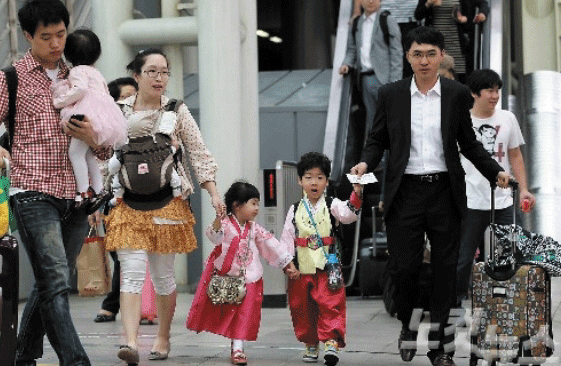To celebrate Chuseok Mid-Autumn Full Moon Festival
A total of 35,230,000 million people visited their hometowns from Seoul and other major cities in Korea to their hometowns in the countryside to celebrate the Chuseok Full Moon Festival with their parents, relatives and old friends during the three-day Chuseok Holidays.

This year employees of the government organizations and big businesses were given an extra day off based on the newly enacted law that provided for a compensatory holiday when Saturday and/or Sunday fell in the legal holiday period of Chuseok and other festive occasions.

During the holiday period, almost all the expressways and national routes are extremely crowded as well as the railroad trains and cross-county buses. However, this year the situation is a little better thanks to the extra holiday, which had the effect of dispersing the motorists visiting their homes.

One of the most prominent traditional practices of Chuseok at every home is Charye (ancestral rite) where foods, fruits and wines made with the newly harvested crops are offered to the ancestors for another bumper crop next year, good health for the family members and for various other things of good luck, especially wealth.

Charye, literally, means ‘Tea Rite’ but in fact no tea is offered to the ancestors. Instead, rice wine is offered for the deceased parents, grandparents and great grandparents.
Unlike the lunar New Year and other ancestral rites where steamed rice and soup are offered, at Chuseok only Songpyeon (pine rice cakes) are offered in lieu of the rice and soup. This is why in the spoon-chopsticks bowl on the food table for the ancestors, only chopsticks are placed.
The practices of the Chuseok ancestral rites slightly differ depending on the different localities and also on the culture of the families. However, there is a manual showing where to put what foods or beverages on the table. It indicates:
Fish on the east and meat on the west and the head of the fish must face the east while the tail does the west.
Dried fish must be put on the left and salt-pickled fish on the right.
The tablet of the deceased father must be placed on west with all his food and beverages in its vicinity. The place of the deceased mother is on the east. Roasted meat is placed in the center of the table.
As for the fruits and nuts, dish of the dried dates, persimmons, apples and fruits of red color must be placed on the east while chestnuts, pears and other ‘white’ fruits and nuts are placed on the west.
So, since when have the Korean people been celebrating the Chuseok Festival?
It is believed that Koreans have been celebrating the Festival for thousands of years but that the first written record of the Festival appears in Samguk Sagi (The Chronicles of the Three States) of the 12th Century, which states that Chuseok was celebrated in the early period of Silla Kingdom (BC57-AD935) and which indicates that it was one of the prominent festivals of the Silla Kingdom.
The Chronicles state that in the 9th Year of King Yuri of the Silla Dynasty (Third King of Silla who ruled the Kingdom, from AD24 to AD57) were formed six different departments and divided them into two separate teams and had his two Princesses, one to lead each team, in a weaving contest.
The contest began on the 16th Day of the Seventh Month of the Lunar Calendar and lasted one month until the 14th Day of the Eighth Month. Then on Chuseok on the 15th Day of the Month the winning team was selected.
The losing team prepared food and beverage and treated the winning team to a feast with them. The participants in the contest enjoyed the food singing songs and dancing. They called it Gabae.
Traditionally, Koreans have many games on Chuseok, which include Ganggang Sullae circle dance of women, tug-of-war, sedan chair contest, bull game, turtle game and cock fight.
It is also said that Chuseok marks the day when Silla won a great victory over the rival Kingdom of Baekje. It is also said that archery competitions and martial arts demonstrations were held as part of the festivities.
Many scholars believe that Chuseok may originate from ancient shamanistic celebrations of the harvest moon. New harvests are offered to local deities and ancestors, which means Chuseok may have originated as a worship ritual.
One of the major foods prepared and eaten during the Chuseok holiday is Songpyeon, a Korean traditional rice cake which contains stuffing made with healthy ingredients such as sesame seeds, black beans, mung beans, cinnamon, pine nut, walnut, chestnut, jujube, and honey. When making songpyeon, steaming them over layers of pine-needles is critical.
The word “song” means a pine tree in Korean. The pine needles not only contribute to songpyeon’s aromatic fragrance, but also its beauty and taste. Songpyeon is also significant because of the meaning contained in its shape. Songpyeon’s rice skin itself resembles the shape of a full moon, but once it wraps the stuffing, its shape resembles the half-moon.
Since the Three Kingdoms Era in Korean history, there was a Korean legend that these two shapes ruled the destinies of the two greatest rival kingdoms, Baekje and Silla.

During the era of King Uija of Baekje (31st and last king of Baekje) who ruled the kingdom from AD641 to AD 660, there was an encrypted phrase, “Baekje is full-moon and Silla is half moon,” which was found on the back of a turtle. It predicted the collapse of the Baekje and the rise of the Silla Kingdom who attacked Baekje in cooperation with the Tang Dynasty of China. Ever since this, Koreans started to refer to a half-moon shape as the indicator of the bright future or victory. Therefore, during Chuseok, families gather together and eat half-moon shaped Songpyeon under the full-moon, wishing themselves a brighter future.

